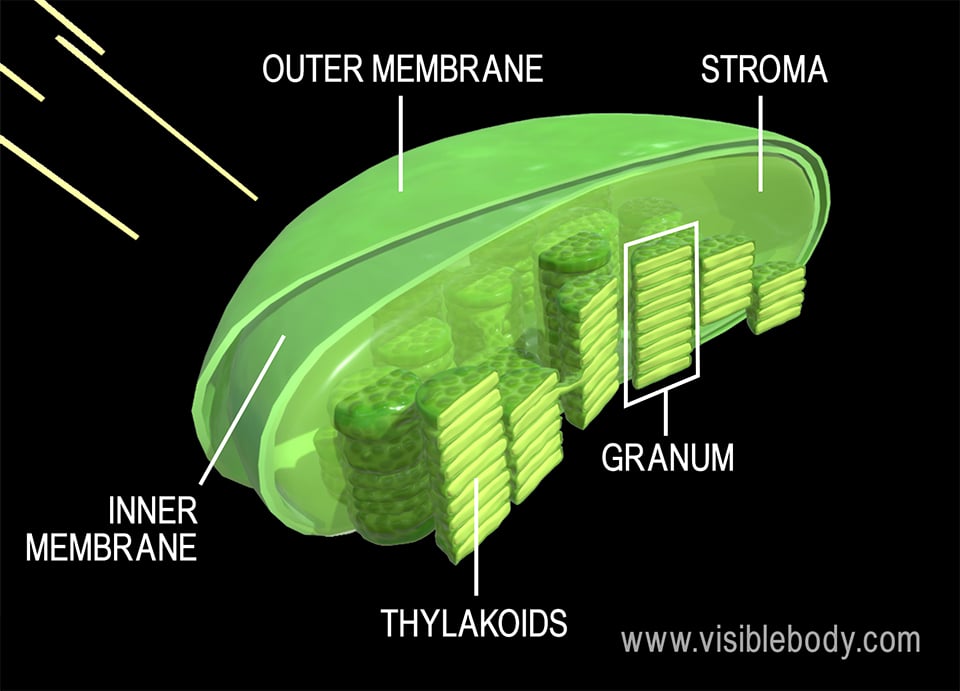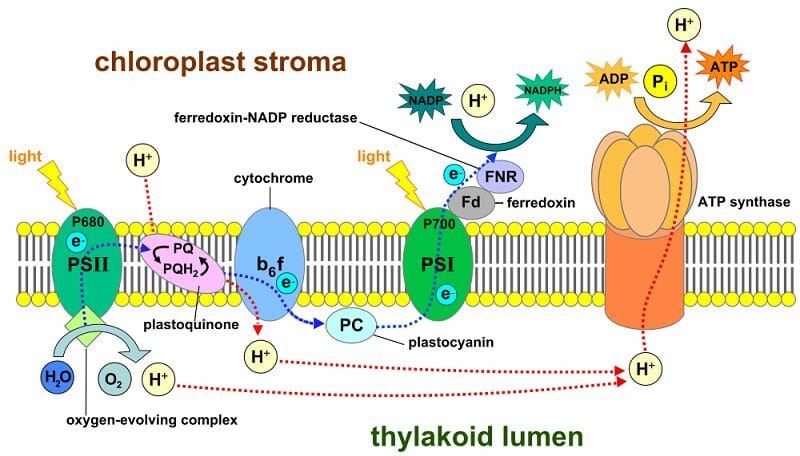Is the stroma light dependent? This question delves into the heart of photosynthesis, the process by which plants convert sunlight into energy. While the answer might seem straightforward, the reality is more intricate. The stroma, a gel-like substance within chloroplasts, serves as the site for the Calvin cycle, the process that fixes carbon dioxide and ultimately produces sugars. However, the Calvin cycle itself is not directly light-dependent, relying instead on energy carriers produced in the light-dependent reactions that occur within the thylakoid membranes.
This intricate dance between the stroma and the thylakoid membranes highlights the interconnectedness of photosynthesis. The light-dependent reactions capture sunlight’s energy and convert it into ATP and NADPH, which then fuel the Calvin cycle within the stroma. This intricate interplay between these two phases is what allows plants to harness the power of the sun and sustain life on Earth.
Stroma
The stroma is the semi-fluid, colorless matrix that fills the space between the thylakoid membranes in a chloroplast. It’s a dynamic environment where the Calvin cycle, the light-independent stage of photosynthesis, takes place. This intricate process converts carbon dioxide into sugars, forming the foundation for all organic matter on Earth.
Stroma Composition and Structure
The stroma is composed of a complex mixture of proteins, enzymes, lipids, and inorganic ions, all working in harmony to support the metabolic processes of the chloroplast. The stroma is a highly organized environment, containing a network of protein fibers that provide structural support and facilitate the movement of molecules. This intricate network helps regulate the flow of materials and ensures efficient functioning of the Calvin cycle.
Key Components of the Stroma
- Enzymes: The stroma houses a diverse array of enzymes, including those essential for the Calvin cycle. These enzymes catalyze the reactions that convert carbon dioxide into sugars, a crucial step in photosynthesis.
- Ribosomes: The stroma contains ribosomes, which are responsible for protein synthesis. These ribosomes are essential for producing the proteins needed for chloroplast function, including those involved in the Calvin cycle and other metabolic pathways.
- DNA: Chloroplasts have their own DNA, known as chloroplast DNA (cpDNA), located within the stroma. This DNA encodes for proteins involved in chloroplast function, including those involved in photosynthesis.
- Starch Granules: Starch granules, the storage form of glucose, are often found within the stroma. They accumulate as a result of the Calvin cycle, providing a readily available energy source for the plant.
Comparison of Stroma and Thylakoid Membrane
The stroma and the thylakoid membrane, the interconnected internal membrane system within the chloroplast, have distinct functions. The thylakoid membrane is the site of light-dependent reactions, where light energy is captured and converted into chemical energy in the form of ATP and NADPH. In contrast, the stroma is the site of the Calvin cycle, where carbon dioxide is fixed into sugars using the energy from ATP and NADPH generated in the thylakoid membrane.
| Feature | Stroma | Thylakoid Membrane |
|---|---|---|
| Location | Semi-fluid matrix surrounding thylakoids | Interconnected internal membrane system within the chloroplast |
| Function | Site of the Calvin cycle (light-independent reactions) | Site of light-dependent reactions, where light energy is converted into chemical energy |
| Key Components | Enzymes, ribosomes, DNA, starch granules | Photosystems, electron transport chain, ATP synthase |
Light-Dependent Reactions: Is The Stroma Light Dependent

The light-dependent reactions, the first stage of photosynthesis, harness the energy of sunlight to create energy carriers that power the Calvin cycle. This process takes place within the thylakoid membranes of chloroplasts, where specialized pigment molecules, primarily chlorophyll, capture light energy.
Light Absorption by Chlorophyll
Chlorophyll, the green pigment responsible for absorbing light energy, resides within the thylakoid membrane. When a chlorophyll molecule absorbs a photon of light, an electron within the molecule becomes energized and jumps to a higher energy level. This excited electron can then be passed along an electron transport chain, initiating the process of energy conversion.
Generating ATP and NADPH
The light-dependent reactions utilize the energy captured from light to produce ATP (adenosine triphosphate) and NADPH (nicotinamide adenine dinucleotide phosphate), essential energy carriers for the Calvin cycle. These molecules are generated through a series of steps involving photosystems I and II.
Photosystems I and II
Photosystems I and II are protein complexes embedded within the thylakoid membrane, each containing a reaction center chlorophyll molecule surrounded by antenna pigments. These antenna pigments capture light energy and funnel it to the reaction center chlorophyll.
- Photosystem II: The initial step involves Photosystem II, where light energy excites an electron in the reaction center chlorophyll. This energized electron is passed along an electron transport chain, releasing energy that is used to pump protons (H+) across the thylakoid membrane, creating a proton gradient. This gradient is then used by ATP synthase to produce ATP through chemiosmosis.
- Photosystem I: After passing through Photosystem II, the electron eventually reaches Photosystem I, where it is re-energized by light. This re-energized electron is then used to reduce NADP+ to NADPH, a reducing agent essential for the Calvin cycle.
Key Steps in Light-Dependent Reactions
| Step | Description | Role of Photosystems |
|---|---|---|
| 1. Light Absorption | Chlorophyll molecules absorb light energy, exciting electrons. | Photosystems I and II capture light energy and transfer it to reaction center chlorophyll. |
| 2. Electron Transport Chain | Excited electrons are passed along an electron transport chain, releasing energy used to pump protons across the thylakoid membrane. | Photosystem II initiates the electron transport chain. |
| 3. ATP Production | The proton gradient created by electron transport drives ATP synthase to produce ATP through chemiosmosis. | Photosystem II indirectly contributes to ATP production by generating the proton gradient. |
| 4. NADPH Production | Electrons from Photosystem I are used to reduce NADP+ to NADPH. | Photosystem I provides the re-energized electrons for NADPH production. |
The Calvin Cycle

The Calvin cycle, also known as the Calvin-Benson cycle, is a series of biochemical reactions that take place in the stroma of chloroplasts during photosynthesis. This cycle utilizes the energy stored in ATP and NADPH produced by the light-dependent reactions to convert carbon dioxide into glucose, the primary energy source for most living organisms. The Calvin cycle is divided into three main stages: carbon fixation, reduction, and regeneration.
Carbon Fixation
Carbon fixation is the initial step in the Calvin cycle, where carbon dioxide from the atmosphere is incorporated into an organic molecule. This process is catalyzed by the enzyme Rubisco (ribulose-1,5-bisphosphate carboxylase/oxygenase), which is one of the most abundant enzymes on Earth. Rubisco binds to a five-carbon sugar called ribulose-1,5-bisphosphate (RuBP) and catalyzes its reaction with carbon dioxide, forming an unstable six-carbon intermediate.
This intermediate quickly breaks down into two molecules of 3-phosphoglycerate (3-PGA), a three-carbon compound.
Rubisco + RuBP + CO2 → unstable six-carbon intermediate → 2 molecules of 3-PGA
Reduction
The reduction stage involves the conversion of 3-PGA into glyceraldehyde-3-phosphate (G3P), a three-carbon sugar that is the primary product of the Calvin cycle. This process requires energy from ATP and reducing power from NADPH, both produced by the light-dependent reactions. First, 3-PGA is phosphorylated by ATP to form 1,3-bisphosphoglycerate. Then, NADPH reduces 1,3-bisphosphoglycerate to G3P. For every six molecules of carbon dioxide fixed, twelve molecules of G3P are produced.
- -PGA + ATP → 1,3-bisphosphoglycerate + ADP
- ,3-bisphosphoglycerate + NADPH → G3P + NADP+ + Pi
Regeneration
The regeneration stage involves the recycling of five out of every six molecules of G3P to regenerate RuBP, the starting molecule for the Calvin cycle. This process requires ATP and involves a series of complex enzymatic reactions. The regeneration of RuBP ensures that the Calvin cycle can continue to fix carbon dioxide and produce G3P.
G3P + 3 ATP → 3 RuBP + 2 Pi + 2 H2O
Stroma’s Role in Photosynthesis

The stroma, a semi-fluid matrix within the chloroplast, plays a crucial role in photosynthesis, serving as the site for the Calvin cycle, the light-independent reactions. It is interconnected with the light-dependent reactions, receiving essential products that power the synthesis of sugars.
Interconnectedness with Light-Dependent Reactions
The stroma’s role in photosynthesis is intimately tied to the light-dependent reactions occurring in the thylakoid membranes. The light-dependent reactions generate ATP and NADPH, which are transported to the stroma, providing the energy and reducing power necessary for the Calvin cycle.
- ATP, the energy currency of the cell, is produced by the proton gradient established across the thylakoid membrane during the light-dependent reactions. This gradient drives ATP synthase, which generates ATP in the stroma.
- NADPH, a reducing agent, is produced by the electron transport chain in the thylakoid membrane. It carries high-energy electrons, essential for the reduction of carbon dioxide in the Calvin cycle.
Suitable Environment for Calvin Cycle Enzymes, Is the stroma light dependent
The stroma provides a suitable environment for the enzymes involved in the Calvin cycle. Its semi-fluid nature allows for the free movement of enzymes and substrates, facilitating efficient biochemical reactions.
- The stroma’s pH is slightly alkaline, which is optimal for the activity of many Calvin cycle enzymes.
- The stroma contains high concentrations of inorganic ions, such as magnesium (Mg 2+), which are essential cofactors for several Calvin cycle enzymes.
Efficiency of Photosynthesis
The stroma contributes to the overall efficiency of photosynthesis by facilitating the conversion of light energy into chemical energy.
- The Calvin cycle, taking place in the stroma, utilizes the energy and reducing power generated by the light-dependent reactions to fix carbon dioxide, producing glucose. This process efficiently converts light energy into chemical energy stored in the bonds of glucose.
- The stroma’s environment optimizes the activity of the Calvin cycle enzymes, ensuring a high rate of carbon fixation and efficient utilization of ATP and NADPH.
Understanding the relationship between the stroma and the light-dependent reactions is crucial for comprehending the intricacies of photosynthesis. The stroma, while not directly light-dependent, plays a vital role in converting light energy into chemical energy, ultimately leading to the production of sugars that sustain life. This intricate dance between these two phases, a testament to the elegance of nature’s design, underscores the importance of studying the fundamental processes that drive life on Earth.
FAQs
What are the key enzymes involved in the Calvin cycle within the stroma?
The Calvin cycle relies on several key enzymes, including Rubisco, which catalyzes the initial carbon fixation step, and other enzymes involved in the reduction and regeneration phases.
How does the stroma contribute to the overall efficiency of photosynthesis?
The stroma provides a suitable environment for the enzymes involved in the Calvin cycle, ensuring their optimal activity. It also facilitates the flow of energy carriers, ATP and NADPH, from the light-dependent reactions to the Calvin cycle, enhancing the overall efficiency of photosynthesis.
Is the stroma involved in any other processes besides the Calvin cycle?
While the Calvin cycle is the primary function of the stroma, it also houses other metabolic processes, such as the synthesis of amino acids and fatty acids, highlighting its role as a central hub within the chloroplast.





